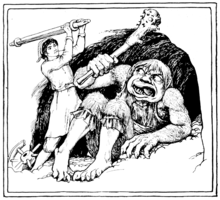Tom Hickathrift

Tom Hickathrift (or sometimes Jack Hickathrift) is a legendary figure of East Anglian English folklore — a character similar to Jack the Giant Killer. He famously battled a giant, and is sometimes said to be a giant himself, though normally he is just represented as possessing giant-like strength.
Various stories of his exploits have grown up. In one version he is fabled to have been a simple labourer at the time of the Norman Conquest and to have killed a giant in the marsh at Tilney, Norfolk armed only with an axle-tree stuck into a cartwheel. When his makeshift weapon broke he grabbed a "lusty rawboned miller" and used him as a weapon instead. This exploit earned him the governorship of Thanet.[1] At the church in Walpole St Peter there is a dent in the ground, where it is said a cannonball landed after he threw it to scare away the devil (in this version Tom is a giant).[2]
In the fairy tale as told by Joseph Jacobs, Tom lived in marsh of the Isle of Ely and although initially lazy and gluttonous, he was prodigiously tall and it soon became apparent that he had the strength of twenty men. Various proofs of his strength are given: he carried twenty hundredweight of straw and a tree as if they weighed nothing, kicked a football so far that nobody could find it and turned the tables on four men who tried to rob him. He eventually got a job carting beer in Wisbech, but the long journey tired him, so one day he cut across the land of the Wisbech Giant. The giant took this badly and fetched his club to beat Tom, but at this point Tom took the axle-tree and cartwheel and fought the giant. After a furious battle the giant was killed. Tom took his land and was from then on held in esteem by the people of the area.[3]
Jacobs cites his source as the chapbook in the Pepysian Library from around 1660, edited by G. L. Gomme. Gomme's introduction states that there was evidence that an axle-tree and cartwheel had figured on a stone tomb in Tilney churchyard and local accounts associated these with a man named Hickifric who had withstood the tyranny of the lord of the manor.[3]
It has been suggested that he echoes the Norse god Thor (Anglo-Saxon: Þunor): they were both known for fighting giants, ate prodigiously and used a hammer-like weapon (there is even a suggestion that the "miller" and Thor's hammer Mjolnir come from the same source).[4]
He is mentioned in Laurence Sterne's Tristram Shandy and Lavengro by George Borrow, although Borrow places his exploits as far north as Lincolnshire. The elaborate moulded plasterwork (pargeting) decorating the Old Sun Inn in Saffron Walden, Essex features his battle against the Wisbech Giant.
A character named Hiccafrith, based on Tom, appears in Marcus Pitcaithly's Hereward trilogy.
Notes
- ↑ Brewer's Concise Dictionary of Phrase and Fable. London: Helicon Publishing. 1992. p. 499. ISBN 1-85986-286-1.
- ↑ Barbara Holmes (July 2006). "Fenland Family History Society: Walpole St. Peter Church". Retrieved 30 October 2006.
- 1 2 Jacobs, Joseph, ed. (1894). More English Fairy Tales. New York: G. P Putnam's and Sons.
- ↑ Lina Eckenstein (1906). Comparative Studies In Nursery Rhymes. London: Duckworth and Co. p. 54.
External links
| Wikisource has original text related to this article: |